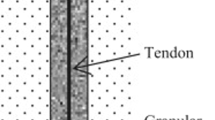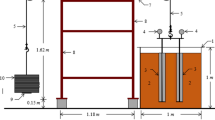Abstract
The paper presents methods for the estimation of the ultimate pullout capacities of Granular Pile Anchors (GPA) for homogeneous and non-homogeneous (undrained strength increasing linearly with depth) ground conditions as the lesser of the two values obtained considering shear and bulging failure mechanisms. The ultimate pullout capacity and the critical lengths of GPA corresponding to a transition from shear failure to bulging failure are evaluated as functions of various parameters such as the length to diameter ratio, L/d, of GPA, the ratio of the shear modulus to undrained strength, G/cu, of the ground, the undrained shear strength of soil, cu, unit weight, γgp, the angle of shearing resistance, ϕgp, of the granular pile material, lateral coefficient of earth pressure, K0, etc. The variations of ultimate capacities and critical lengths are presented as functions of several parameters under investigation. The influence of non-homogeneous strength parameter, α, on the ultimate capacities and critical length is also investigated. The predictions are validated with limited test results available in literature [Caskey in Uplift capacity of rammed aggregate piers soil reinforcing elements, Thesis, University of Memphis, MS, 2001; Lillis C, Lutenegger AJ, Adams M (2004) Compression and uplift of rammed aggregate piers in clay. Geosupport: ASCE/GEO Geotechnical Special Publication No 14, 497–507]. The paper presents methods to estimate ultimate pullout capacity of granular pile anchors for homogeneous and non-homogeneous ground conditions. The ultimate capacity of GPA increases with increasing undrained shear strength of soil and resistance shifts to deeper depths in GPA unlike the granular piles which are independent of length. Theoretical results are validated with field test results.











Similar content being viewed by others
Data availability
The data and material presented in this paper are available.
Code availability
Not applicable.
Abbreviations
- c u :
-
Undrained strength of in-situ soil
- c uo :
-
Undrained strength of in-situ soil at ground level
- D :
-
Diameter of GPA
- G :
-
Shear Modulus of in-situ soil
- K 0 :
-
Coefficient of lateral earth pressure at rest
- L :
-
Length of GPA
- L cr :
-
Critical length of GPA
- N* c :
-
Bearing capacity factor
- P ult :
-
Ultimate pullout capacity of GPA
- P* :
-
Normalized pullout capacity of GPA
- γ gp :
-
Unit weight of granular pile material
- γ s :
-
Saturated unit weight of in-situ soil
- γ sub :
-
Submerged or buoyant unit weight of in-situ soil
- ϕ gp :
-
Angle of shearing resistance of granular pile material
- β :
-
Lateral confining stress parameter
- λ :
-
Relative density of the pile material
- α c :
-
Non-homogeneity parameter of the undrained shear strength of soil
- GPA:
-
Granular Pile Anchors
- RCC:
-
Reinforced Cement Concrete
References
Datye K.R., Nagaraju S.S. (1975) Installation and testing of rammed stone columns. proceedings of indian geotechnical society, In: 5th ARC on SMFE, Bangalore, 101–104.
Priebe HJ (1976) Evaluation of the Settlement Reduction of a Foundation Improved by Vibro-Replacement. Bautechnik, No 5:160–162
Balaam NP, Poulos HG, Brown PT (1977) Settlement analysis of soft clays reinforced with granular piles. In: Proceedings of 5th Asian Regional Conference (ARC), Bangkok, Thailand, 1, 81–92.
Balaam NP (1978) Method of analysis of single stone column. research report No.R335, School of Civil Engineering, University of Sydney, Australia.
Balaam N.P., Poulos H.G. (1978) Method of analysis of single stone column. Research Report No. R335, School of Civil Engineering, University of Sydney, Australia.
Van Impe WF, De Beer E (1983) Improvement of Settlement Behavior of Soft Layers by means of Stone Columns. In: Proceedings of the 8th European Conference on Soil Mechanics and Foundation Engineering: Improve Ground Helsinki, 1: 309–312.
Bergado DT, Rantucci G, Widdodo S (1984) Full scale load test of granular piles and sand drains in soft Bangkok clay. In: Proceedings of International Conference on In Situ and Rock Reinforcement, Paris, 111–118.
Lee JS, Pande GN (1998) Analysis of stone-column reinforced foundations. Int J Numer Anal Method Geomech 22(12):1001–1020
Sivakumar V, Jeludine DKNM, Bell A, Glynn DT, Mackinnon P (2011) The pressure distribution along stone columns in soft clay under consolidation and foundation loading. Geotechnique 61(7):613–620
Madhav MR, Arlekar, JN (2000) Dilation of granular piles in mitigating liquefaction of sand deposit. In: Proceedings of 12th World Conference on Earthquake Engineering, Auckland, New Zealand.
Seed HB, Booker JR (1977) Stabilization of potentially liquefaction sand deposit using gravel drains. J Geotech Eng Div, ASCE 103(GT7):757–768
Seed HB, Martin PP, Lysmer J (1976) Pore water pressure changes during soil liquefaction. J Geotech Eng Div, ASCE 102(GT4):323–346
Sabhahit N, Basudhar PK, Madhav MR (1997) Generalised stability analysis of embankments on granular piles. Soil Found 37(4):13–22
White D, Wissmanm K, Lawton E (2001). Geopier reinforcement for transportation application. Geotechnical News, 63–68.
Wissmann KJ, Fox NS (2000a). Design and analysis of short aggregate piers used to reinforce soils for foundation support. In: Proceedings, Geotechnical Colloquium. Technical University Darmstadt. Darmstadt, Germany
Wissmann K. J., Fox N. S., Martin, J. P. (2000b). Rammed aggregate piers defeat 75-foot long75-foot-long driven piles. Performance Confirmation of Constructed Geotechnical Facilities, ACSE Geotechnical Special Publication No. 94, April 9–12. Amherst Massachusetts.
Phanikumar BR, Rao NR (2000) Increasing pullout capacity of granular pile anchors using base geosynthetics. Can Geotech J 37:870–881
Phanikumar BR, Sharma RS, Srirama RA, Madhav MR (2004) Granular pile anchor foundation (GPAF) system for improving the engineering behaviour of expansive clay beds. Geotech Test J, American Standard Test Mach 27(3):1–9
Sharma RS, Phanikumar BR (2005) Laboratory study of heave behaviour of expansive clay reinforced with geopiles. J Geotech Geoenviron Eng, ASCE 131(4):512–520
Kumar, P., Ranjan, G., Saran, S. (2003) GAP system for resistance of uplift forces – a field study. In: Proceedings of Indian Geotechnical Conference, 597–602.
Narayanaswamy Setty KR., Ravi Shanker AU., Narasimha Reddy GN (2000) “Uplift behaviour of granular pile-anchors in expansive soils. In: Indian Geotechnical Conference, IIT Bombay, 305–306.
Neenu Johnson, Sandeep M N (2015) Ground improvement using granular pile anchor foundation. In: International Conference on Emerging Trends in Engineering, Science and Technology (ICETEST - 2015).
Ranjan G, Kumar P (2000) Behaviour of granular piles under compressive and tensile loads. Geotech Eng J SEAGS 31(3):209
Lawton EC (2000) Performance of Geopier foundations during simulated seismic tests at South Temple Bridge on Interstate 15, Salt Lake City, Utah. Final Report No UUCVEEN 00–03, University of Utah, Salt Lake City, Utah.
Caskey JM (2001) Uplift capacity of rammed aggregate piers soil reinforcing elements. Thesis, University of Memphis, MS
Farrell T., Patrick B. F., Kenney W. (2008) Uplift testing of rammed aggregate pier systems. In: Proceedings of the Conference of Geotechnical Earthquake Engineering and Soil Dynamics IV, Sacramento, California.
Hsu CL (2000) Uplift capacity of geopier foundations. Thesis, University of Utah, M. S
Lawton EC, Fox NS, Handy RL (1994) Control of settlement and uplift of structures using short aggregate piers. ASCE National Convention, Atlanta, Georgia, In-situ Deep Soil Improvement, Proc
Lillis C, Lutenegger AJ, Adams M (2004) Compression and uplift of rammed aggregate piers in clay. Geosupport: ASCE/GEO Geotechnical Special Publication No 14, 497–507.
Liu K-F, Xie X-Y, Zhang J-F, Zhu X-R (2006) Compression/ tension load capacity of stone column anchors. Proc ICE-Geotech Eng 159(3):161–165
Sivakumar V, O’Kelly BC, Madhav MR, Moorhead C, Rankin B (2013) Granular anchors under vertical loading – axial pull. Can Geotech J 50(2):123–132
Krishna PH, Murty VR (2013) Pull-out capacity of granular anchor piles in expansive soils. IOSR-JMCE 5(1):24–31
Eswara Reddy O, Gruruprasad VD (2019) Load settlement response of geotextile encase laterally reinforced granular piles in expansive soil under compression. Int J Geosynth Ground Eng. https://doi.org/10.1007/s40891-019-0168-8
Eswara Reddy O, Madhav MR, Reddy ES (2015) Ultimate pullout capacity of the granular pile anchors by laboratory model tests. Indian J Geosynth Ground Improv 4(1):25–33
Eswara Reddy O, Madhav MR, (2014) Ground improvement by granular pile anchors–A laboratory study. 30–31, Geo-Innovations, IGS Bangalore
Abhishek VS, Rajalakshmi K, Madhav MR (2016) Engineering of Ground with Granular Piles: A Critical Review. Int J Geotech Engg. https://doi.org/10.1080/19386362.2016.1145942
Pradeep K, Mohit K, Chandaluri VK, Sawant VA (2018) Uplift capacity of single and group of granular anchor pile system. J Civl Eng, Sci Technol 9(1):34–40
Sharma A, Sharma R (2019) An experimental study on uplift behaviour of granular anchor pile in stabilized expansive soil. Int J Geotech Eng. https://doi.org/10.1080/19386362.2019.1597481
Hans RV, Samant VA (2021) An experimental Investigation for Pullout response of a single granular pile anchor in Clayey Soil. Int J Geo-Eng. https://doi.org/10.1186/s40703-021-00162-3
Kakustham K, Krishna R (2021) Analytical study on failure of granular anchor pile. Mater Today Proc 46(4):8393–8396. https://doi.org/10.1016/j.matpr.2021.03.443
Osmana Kh, Nusier AS, Alawneh AA (2023) The efficiency of granular pile anchor foundation system in reducing heave of Irbid expansive clayey soil: an experimental investigation. Case Stud Construct Mater. https://doi.org/10.1016/j.cscm.2023.01846
Phanikumar BR, Raghuram ASS, Sriramarao A (2020) Improving expansive clay beds with granular pile anchors (GPAs) and geogrid-encased GPAs. Proc Inst Civil Eng Ground Improv 173(4):237–248. https://doi.org/10.1680/jgrim18.0008
Gibson RE, Anderson WF (1961) In-Situ measurement of soil properties with the pressure meter. Civ Engrg Publ Works Rev 56:658
Hughes JMO, Withers NJ (1974) Reinforcing soft cohesive soil with stone columns. Ground Eng 7(3):42–49
Hughes JMO, Withers NJ, Greenwood DA (1975) A field trial of the reinforced effect of stone column in soil. Geotechnique 25(1):31–44
Vidyaranya B (2012) Ultimate capacity and displacement analysis of single and group of granular pile anchors. Ph.D Thesis, Osmania University, Hyderabad
Funding
This research did not receive any specific grant from funding agencies in the public, commercial, or not-for-profit sectors.
Author information
Authors and Affiliations
Contributions
ERO and VB conceptualized and carried out the analysis, studied the results, and contributed to writing original draft preparation, reviewing and editing under the supervision of MRM.
Corresponding author
Ethics declarations
Conflict of interest
The authors declare that there are no potential competing interests concerning the research, authorship, and/or publication of this study.
Ethical approval
This article is the authors' own original research work, which has not been previously published elsewhere. Further, the paper is not currently being considered for publication elsewhere.
Informed consent
The authors declare that there is no involvement of Human Participants and/or Animals concerning this research.
Rights and permissions
Springer Nature or its licensor (e.g. a society or other partner) holds exclusive rights to this article under a publishing agreement with the author(s) or other rightsholder(s); author self-archiving of the accepted manuscript version of this article is solely governed by the terms of such publishing agreement and applicable law.
About this article
Cite this article
Orekanti, E.R., Bandi, V. & Madhav, M.R. Ultimate capacity of granular pile anchors. Innov. Infrastruct. Solut. 8, 317 (2023). https://doi.org/10.1007/s41062-023-01259-7
Received:
Accepted:
Published:
DOI: https://doi.org/10.1007/s41062-023-01259-7




